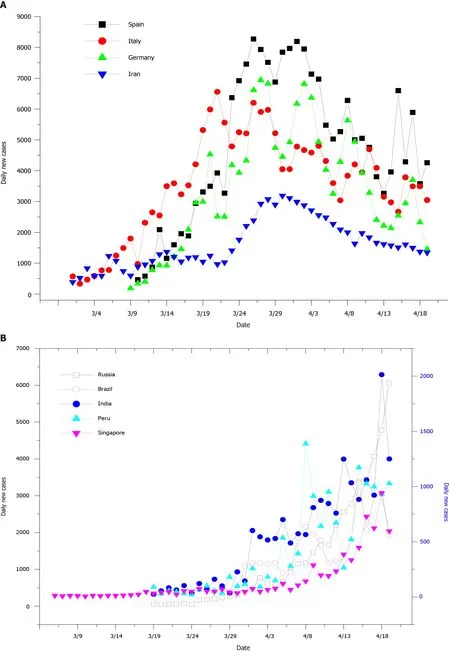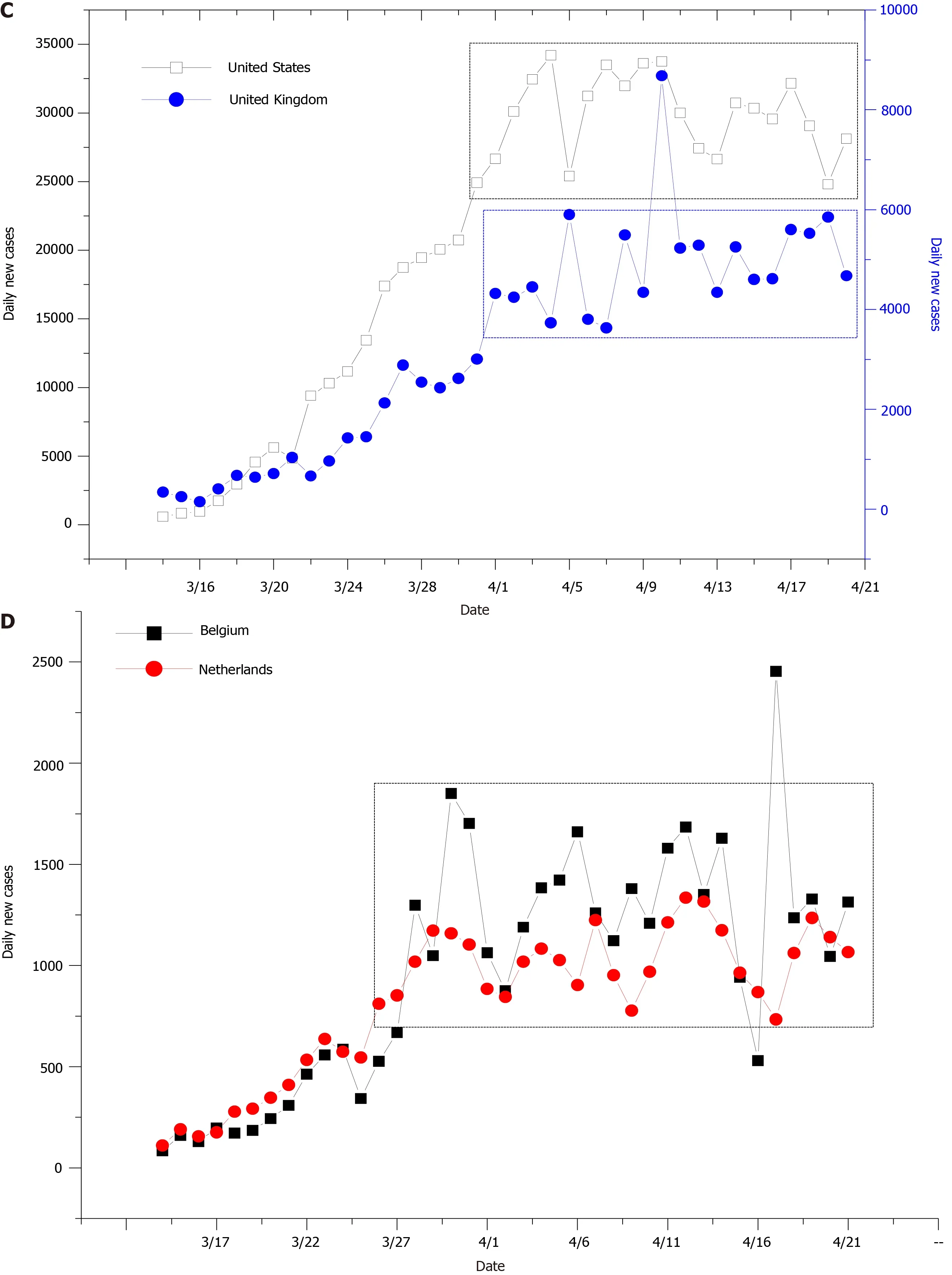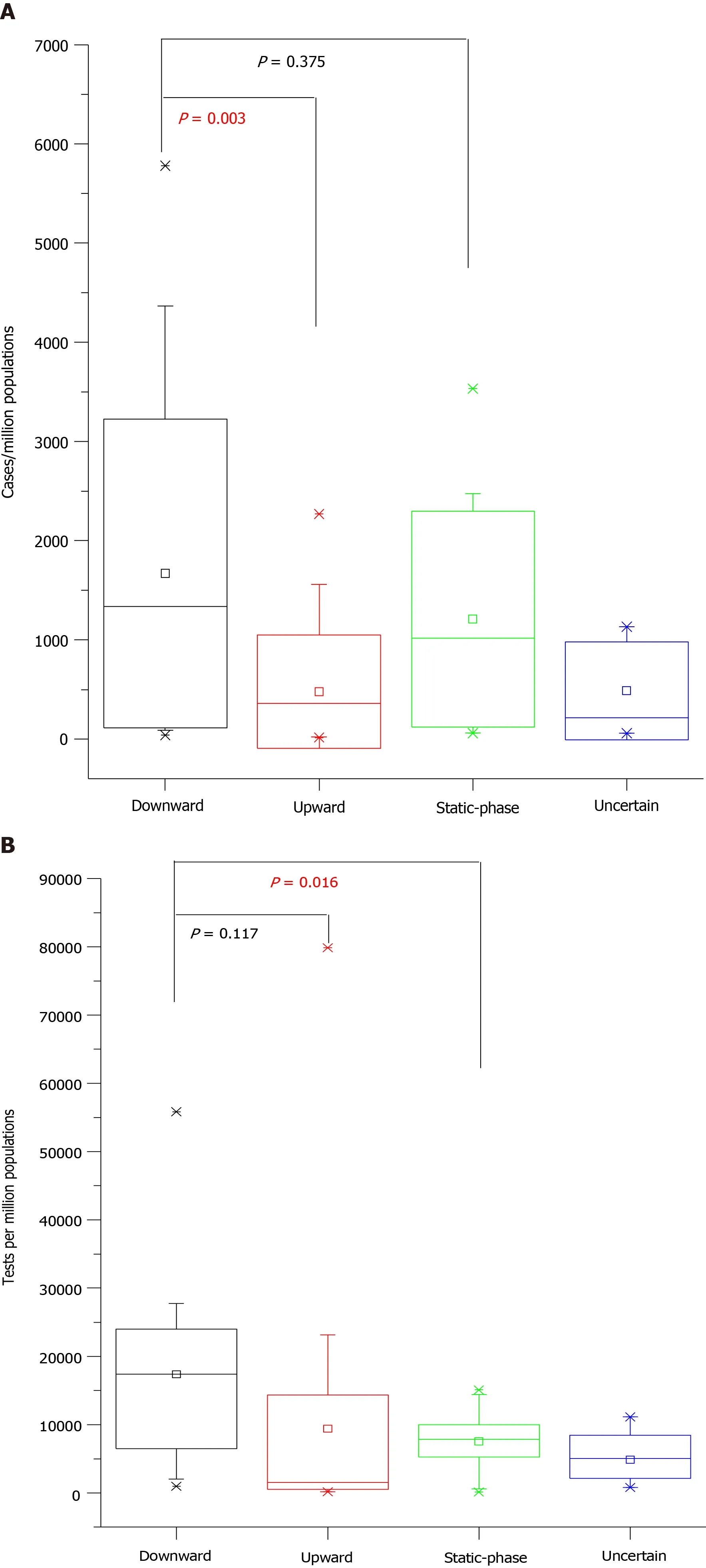Global analysis of daily new COVID-19 cases reveals many staticphase countries including the United States potentially with unstoppable epidemic
Cheng Long,Xin-Miao Fu,Zhi-Fu Fu
Cheng Long,Department of Orthopaedics,Sichuan University West China Hospital,Chengdu 610041,Sichuan Province,China
Xin-Miao Fu,College of Life Sciences,Fujian Normal University,Fuzhou 350117,Fujian Province,China
Zhi-Fu Fu,Anxi AIER Eye Hospital(AIER EYE Hospital Group),Anxi 362400,Fujian Province,China
Abstract BACKGROUND The coronavirus disease 2019(COVID-19)pandemic is hitting many countries.It is hypothesized the epidemic is differentially progressing in different countries.AIM To investigate how the COVID-19 epidemic is going on in different countries by analyzing representative countries.METHODS The status of COVID-19 epidemic in over 60 most affected countries was characterized.The data of daily new cases of each country were collected from Worldometer.The data of daily tests for the United States,Italy,and South Korea were collected from the Website of One World Data.Levels of daily positive COVID-19 tests in the two most affected states of the United States(New York and New Jersey)were collected from the website of the COVID Tracking Project.Statistics were analyzed using Microcal Origin software with ANOVA algorithm,and significance level was set at a P value of 0.05.RESULTS The COVID-19 epidemic was differentially progressing in different countries.Comparative analyses of daily new cases as of April 19,2020 revealed that 61 most affected countries can be classified into four types:Downward(22),upward(20),static-phase(12),and uncertain ones(7).In particular,the 12 static-phase countries including the United States were characterized by largely constant numbers of daily new cases in the past over 14 d.Furthermore,these static-phase countries were overall significantly lower in testing density(P = 0.016)but higher in the level of positive COVID-19 tests than downward countries(P = 0.028).These findings suggested that the testing capacity in static-phase countries was lagging behind the spread of the outbreak,i.e.,daily new cases(confirmed)were likely less than daily new infections and the remaining undocumented infections were thus still expanding,resulting in unstoppable epidemic.CONCLUSION Increasing the testing capacity and/or reducing the COVID-19 transmission are urgently needed to stop the potentially unstoppable,severing crisis in static-phase countries.
Key Words:COVID-19;SARS-CoV-2;Coronavirus;Pandemic;Testing density
INTRODUCTION
The outbreak of 2019 novel coronavirus disease(COVID-19)has become a pandemic and are devastating more than 150 countries[1,2].As of 23 April 2020,there have been over 2.5 million confirmed COVID-19 cases and 180000 deaths in the world[1].While China and South Korea are close to successfully contain the COVID-19 epidemic by mass testing and implementing comprehensive prevention measures[2],other countries are in battles of different stages against the crisis.We previously forecasted that Italy and the United States were similar to Hubei,China in the severity of the COVID epidemic,and the United States was even more severe than Italy[3].Here we performed analyses on over 60 most affected countries to characterize the status of the epidemic in each country,which may help to get better preparedness and optimize responses and efforts.
MATERIALS AND METHODS
Data source
The data of daily new cases of each country were collected from Worldometer(https://www.worldometers.info/coronavirus/).Levels of daily positive COVID-19 tests in the two most affected states of the United States(New York and New Jersey)were collected from the website of the COVID Tracking Project(https://covidtracking.com/api).The data of daily tests for the United States,Italy,and South Korea were collected from the Website of One World Data(https://ourworldindata.org/grapher/full-list-cumulative-total-tests-per-thousand)and Data for United Kingdom from COVID-19 United Kingdom update(https://covid19uk.live/#/).
Statistical analysis
Statistics were analyzed using Microcal Origin software with ANOVA algorithm,and significance level was set at aPvalue of 0.05.
RESULTS
Identification of static-phase countries with largely constant numbers of daily new cases
We collected the data of daily new cases of the most affected 61 countries(at least with over 1800 total confirmed cases as of April 19,2020)from the website of Worldometer[1]and then compared the trends of daily new cases among them.As summarized in Table 1,these 61 countries can be classified into four type,i.e.,22 downward,20 upward,12 static-phase,and 7 uncertain countries,as described as follows.First,daily new COIVD-19 cases in the 22 downward countries appeared to decline in the past over 14 d after passing peaks.These countries included Spain,Italy,Germany,and Iran(Figure 1A),China and South Korea that have successfully diminished the domestic spread of the virus(Figure S1A),and many others(Figure S1B,S1C,and S1D).Iceland,Japan,and France somehow showed declining trends(Figure S1E and S1F)but need more time to be verified.Second,there were 20 upward countries,in which daily new cases were rapidly(Figures 1A,S2A,and S2B)or slowly(Figure S2C)increasing over time.In particular,Singapore had been believed to contain the epidemic successfully but recently reported a drastic increase in new cases(Figure 1A).Third,daily new cases in the 6 uncertain countries varied so dramatically that it is hard to determine the trends of their epidemic(Figure S3A and S3B);Turkey seemed to stabilize in daily new cases in the past 7 d and needs more time for judgement(Figure S3C).
Strikingly,we found that 12 countries including the United States and United Kingdom entered into static states that were characterized by largely constant numbers of daily new cases in the past over 14 d(as indicated by dotted windows in Figures 1C,1D,and S4A;for detail,refer to Table S1).It has been reported that the incubation period of COVID-19 ranges from 1-14 d with a mean of 5-6 d[4],and therefore maintaining invariable daily new cases within a period of over 14 d is unusual.Notably,such static-phase periods for the United States,United Kingdom,Belgium,and Netherlands were even more than 20 d(Figure 1C and D;Table S1).In addition,Canada and Philippines were close to such static states(Figure S4B),with daily new cases of the former showing a slight increase in the past 4 d and the latter being varying drastically.During revising and resubmitting the manuscript,we closely monitored the newly released data,which suggest that most of the 12 staticphase countries were still constant in daily new cases as of May 3,2020(as shown in bold style,Table 1;for detail,refer to Figure S5),and the United States,Poland,and Sweden were still in static phase as of June 15,2020.
Static-phase countries show significantly lower testing density but higher level of positive COVID-19 tests than downward countries
To unravel why these static-phase countries show invariable daily new case,we compared the four types of countries with respect to case density,testing density,and the level of positive COVID-19 tests(for detail,refer to Table S2).Results indicated that the 12 static-phase countries were overall comparable in the case density with the 22 downward countries(P =0.375;Figure 2A),but they were significantly lower in the testing density(P =0.016;Figure 2B)and higher in the level of positive COVID-19 tests(P =0.028;Figure 2C)than the latter.Consistently,upward countries were significantly lower in case density than downward countries(P =0.003;Figure 2A).These observations raise a possibility that testing capacity may limit the full identification of COVID-19 infected persons in the static-phase countries where relative high levels of infections have been already presented in the community(as indicated by the relatively high level of positive COVID-19 tests;Figure 2C).
The United States and United Kingdom have lower testing intensity but higher level of positive tests than South Korea and Italy
To further verify the above possibility,we compared the daily testing density between typical static-phase countries(United States and United Kingdom)and downward countries(South Korea and Italy).Data presented in Figure 2D indicate that both theUnited States and United Kingdom were lower than Italy in the testing density even if the latter has significantly mitigated the outbreaks in the past month(Figure 1A)while the former two were still expecting the appearance of epidemic peaks.Notably,testing density in South Korea had declined since April but was still comparable with that in the United Kingdom(Figure 2D),although South Korea has approached to the ending stage in the outbreak(Figure S1A).These observations suggested that both the United States and United Kingdom had not yet performed sufficient testing to identify the infected COVID-19 cases in comparison with what Italy and South Korea have done regardless of their epidemic status.

Table 1 Classification of the 61 most affected countries according to their trends of daily new cases
More severely,the United States and United Kingdom had surpassed Italy in the level of positive COVID-19 tests since late March,and in the United States the level of positive tests had been close to the ever highest peak in Italy(up to 30%)occurring in mid-March and in United Kingdom it is even much higher than the latter(up to 50%;Figure 2E).In particular,the levels of positive tests in New York and New Jersey states,the epicenter of the outbreaks in the United States,were even up to 40% and 50%,respectively(Figure S6A),and in other states the levels of positive tests varied from 10%-30%(Figure S6B).These observations implicate that infection levels in the populations of the United States and United Kingdom would be,if not higher,comparable with the highest level of Italy throughout its epidemic.Consistently,the level of positive tests in South Korea was as lower as below 5%,presumably due to the limited spread of the virus in the community and/or mass testing.
DISCUSSION
In summary,we found that among the 61 most affected countries,12 have been in a unique static-phase state with highest throughout the epidemic course but largely invariable daily new cases in the past over 14 d as of April 19,2020.Infection levels among the populations of these static-phase countries were even higher than the downward countries(Figure 2C),and the absolute testing densities in certain staticphase countries including the United States,Belgium,Canada,and Netherlands were even higher than some of the downward countries(e.g.,Malaysia and Greece)(refer to Table S2).It follows that invariable daily new cases in static-phase countries should conceivably result from relative insufficient testing in the context of a large pool of undocumented or unidentified infected cases,which is supported by recent antibody screening in New York[5].Along this logic,daily new(confirmed)cases are most likely less than daily new infections in these static-phase countries.As such,the undocumented or unidentified infected cases would increase over time,which further accelerates the spread of the virus and eventually leads to unstoppable epidemics until the virus has spread to the whole populations.This trend appears to take place in the United States,Sweden,and Poland in light of daily new cases since May(Note:Daily new cases in the United States were still around 20000 in late May and early June[1]).


Figure 1 Daily new cases in typical downward,upward,and static-phase countries over time.A-D:Daily new cases in typical downward(panel A),upward(panel B),and static-phase countries(panels C and D).Other countries of each type are shown in Figure S1,S2,and S4,respectively.Data(as of April 19,2020)were collected from Worldometer[1].For each country,the starting date was set when the cumulative confirmed cases reached 1% of the current cumulative ones as of April 19,2020.Dotted windows in panels C and D show the period(over 14 d)with invariable daily new cases.Results of other countries in these categories are shown in Figures S1,S2,and S4.
Accordingly,expansion of the testing capacity and interruption of transmissions by quarantine measures are critical for containing the COVID-19 outbreaks because the former increases daily new cases and the latter decreases daily new infections.It is expected that the daily new cases will be increased if the testing capacity in staticphase countries can be expanded.In this way,more infected persons would be identified and subsequently isolated and quarantined,which would further reduce the spread of the virus among populations and thus decrease total undocumented or unidentified infections.On the other hand,daily new infections are proportional to total active infections and the secondary attack rate that could only be reduced by quarantine measures,wearing masks,and social distancing[6-8].What China[4,7],Italy[6],and Germany[9]have done for fighting against COVID-19 in these aspects may inform static-phase countries to optimize efforts.Another important measure is the reduction of infections in hospitals(i.e.,nosocomial infection)by implementing strict protocols such as segregation of COVID-19 patients from other patients during admission,strict protection of health workers and so on[4,8,10].
CONCLUSION
Of the 61 most affected countries by COVID-19,we identified 12 static-phase countries that were characterized by largely constant numbers of daily new cases in the past over 14 d as of April 19,2020.In these static-phase countries,daily new cases(confirmed)are likely less than daily new infections,resulting in an unstoppable epidemic.It is recommended to increase the testing capacity and decrease the virus transmission to contain the COVID-19 crisis.


Figure 2 Comparative analyses of coronavirus disease 2019 tests between downward and static-phase countries.A-C:Difference analysis of case density(panel A),testing density(panel B),and level of positive coronavirus disease 2019(COVID-19)tests(panel C)among the four types of countries.Data of each type of countries are plotted as the mean ± SD with 95% confidence interval(in the box),with median being shown as short lines.Statistics were analyzed using Microcal Origin software with ANOVA algorithm,and significance levels(P value)are designated.P values less than 0.05 are colored in red;D and E:Comparisons of time-dependent levels of testing density(panel A)and positive COVID-19 tests(panel B)between typical static-phase countries(United States and United Kingdom)and downward countries(South Korea and Italy).Data for the United States,Italy,and South Korea were collected from the Website of One World Data(URL:https://ourworldindata.org/grapher/full-list-cumulative-total-tests-per-thousand)and Data for United Kingdom from COVID-19 United Kingdom update(URL:https://covid19uk.live/#/).
ARTICLE HIGHLIGHTS
Research background
The coronavirus disease 2019(COVID-19)pandemic is profoundly influencing all the countries in the world.One key characteristic of the COVID-19 pandemic is that the epidemic is differentially progressing in different countries,which complicates the implementation of measures for containment.
Research motivation
Characterization of the status of COVID-19 epidemic in each country may help the government,researchers,and the public to get better prepared for containing the unprecedented outbreaks.
Research objectives
We attempted to characterize the status of COVID-19 epidemic in over 60 most affected countries by analyzing their daily new COVID-19 cases over time.COVID-19 tests and the critical factor affecting the COVID-19 status were also comprehensively analyzed.
Research methods
The data of daily new cases of each country were collected from Worldometer.The data of daily tests for the United States,Italy,and South Korea were collected from the Website of One World Data.Daily positive COVID-19 tests in the two most affected states of the United States(New York and New Jersey)were collected from the website of the COVID Tracking Project.Statistics were analyzed using Microcal Origin software with ANOVA algorithm,and significance level was set at aPvalue of 0.05.
Research results
The COVID-19 epidemic was differentially progressing in different countries.The 61 most affected countries can be classified into four types based on their COVID-19 status:Downward(22),upward(20),static-phase(12),and uncertain ones(7).In particular,the 12 static-phase countries including the United States ere characterized by largely constant numbers of daily new cases in the past over 14 d.Furthermore,these static-phase countries were overall significantly lower in testing density(P =0.016)but higher in the level of positive COVID-19 tests than downward countries(P =0.028).
Research conclusions
COVID-19 epidemic in static-phase countries is potentially unstoppable because their daily new infections may be more than daily new cases(confirmed)due to the relative shortage of the COVID-19 testing capacity.
Research perspectives
The COVID-19 epidemic in static-phase countries cannot be stopped unless the testing capacity is increased and/or the COVID-19 transmission is reduced.As such,daily new cases,testing capacity,and level of positive COVID-19 tests need to be closely monitored to comprehensively evaluate the status of COVID-19 epidemic in these countries.
ACKNOWLEDGEMENTS
The authors are grateful to graduate students(Bo-Yan Lv,Zhong-Yan Li,Zhong-Yu Chen,Shuang Zhang,Feng-Qi Sun,and Zu-Qin Zhang,all from Prof.Xinmiao Fu’s research group at Fujian Normal University)for their help in data collection.
 World Journal of Clinical Cases2020年19期
World Journal of Clinical Cases2020年19期
- World Journal of Clinical Cases的其它文章
- Parathyroid adenoma combined with a rib tumor as the primary disease:A case report
- Displacement of peritoneal end of a shunt tube to pleural cavity:A case report
- Localized primary gastric amyloidosis:Three case reports
- Bochdalek hernia masquerading as severe acute pancreatitis during the third trimester of pregnancy:A case report
- Intravesically instilled gemcitabine-induced lung injury in a patient with invasive urothelial carcinoma:A case report
- Intraosseous venous malformation of the maxilla after enucleation of a hemophilic pseudotumor:A case report
